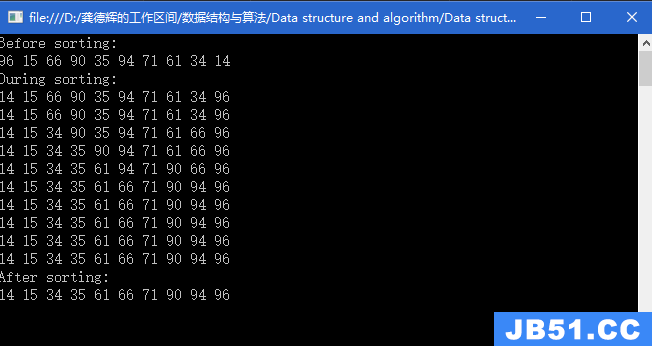头文件:
#pragma once
#include <iostream>
#include <assert.h>
#include <string>
using namespace std;
template<class Type>
class SeqStack
{
public:
SeqStack(size_t sz = INIT_SZ);
~SeqStack();
public:
bool empty()const;
bool full()const;
void show()const;
bool push(const Type &x);
bool pop();
void gettop(Type &x);
int length()const;
void clear();
void destory();
void quit_system(Type &x);
private:
enum{ INIT_SZ = 64 };
Type *base;
int capacity;
int top;
};
template<class Type>
SeqStack<Type>::SeqStack(size_t sz = INIT_SZ)
{
capacity = sz > INIT_SZ ? sz : INIT_SZ;
base = new Type[capacity];
assert(base != NULL);
top = 0;
}
template<class Type>
SeqStack<Type>::~SeqStack()
{
destory();
}
// 判断栈是否满了
template<class Type>
bool SeqStack<Type>::full()const
{
return (top >= capacity);
}
// 判断是否为空栈
template<class Type>
bool SeqStack<Type>::empty()const
{
return (top == 0);
}
// 显示
template<class Type>
void SeqStack<Type>::show()const
{
if (top == 0)
{
cout << "the stack is empty!" << endl;
return;
}
for (int i = top - 1; i >= 0; --i)
{
cout << base[i] << endl;
}
}
// 入栈
template<class Type>
bool SeqStack<Type>::push(const Type &x)
{
if (full())
{
cout << "the stack is full,can not enter!" << endl;
return false;
}
else
{
base[top] = x;
top++;
return true;
}
}
// 出栈
template<class Type>
bool SeqStack<Type>::pop()
{
if (empty())
{
cout << "the stack is empty,can not pop!" << endl;
return false;
}
else
{
top--;
return true;
}
}
// 获得栈顶元素
template<class Type>
void SeqStack<Type>::gettop(Type &x)
{
x = base[top - 1];
}
// 求栈长度
template<class Type>
int SeqStack<Type>::length()const
{
return top;
}
// 清空栈
template<class Type>
void SeqStack<Type>::clear()
{
top = 0;
}
// 摧毁栈
template<class Type>
void SeqStack<Type>::destory()
{
delete[]base;
base = NULL;
capacity = top = 0;
}
// 退出系统
template<class Type>
void SeqStack<Type>::quit_system(Type &x)
{
x = 0;
}
主函数:
#include "exp.h"
#include "exp.h"
//检查符号之间的优先级,1表示>,0表示=,-1表示<,c1栈内的运算,c2栈外的运算
int check(char c1,char c2)
{
int a1,a2;
if (c1 == '+' || c1 == '-')
a1 = 3;
if (c1 == '*' || c1 == '/')
a1 = 5;
if (c1 == '(')
a1 = 1;
if (c1 == ')')
a1 = 7;
if (c1 == '#')
a1 = 0;
if (c2 == '+' || c2 == '-')
a2 = 2;
if (c2 == '*' || c2 == '/')
a2 = 4;
if (c2 == '(')
a2 = 6;
if (c2 == ')')
a1 = 1;
if (c2 == '#')
a2 = 0;
if (a1 > a2)
return 1;
if (a1 == a2)
return 0;
if (a1 < a2)
return -1;
}
//符号运算函数
double sum(char c,double d1,double d2)
{
switch (c)
{
case '+':
return d1 + d2;
break;
case '-':
return d1 - d2;
break;
case '*':
return d1 * d2;
break;
case '/':
return d1 / d2;
break;
default:
break;
}
}
int main()
{
char *op = "+-*/()#";
string str;
cin >> str;
//给表达式字符串str添加‘#’结束标志符
str.append(1,'#');
SeqStack<char> OPTR;//运算符栈
SeqStack<double> OPND;//操作数栈
int a = -1;
//先将'#'入栈
OPTR.push('#');
while (true)
{
int b = a + 1;
a = str.find_first_of(op,a + 1);
if (a == string::npos)
break;
if (a != b)
{
string ss(str,b,a - b);
double d = atof(ss.c_str());
//数据先入栈
OPND.push(d);
}
//运算符优先级比较
char val;
OPTR.gettop(val);
int che = check(val,str[a]);
if (-1 == che)//栈外优先级大直接入栈
{
OPTR.push(str[a]);
}
if (0 == che)//栈内外优先级相等则出栈
{
OPTR.pop();
}
if (1 == che)//栈内优先级大,出栈进行运算
{
char val;
OPTR.gettop(val);
double d1;
OPND.gettop(d1);
OPND.pop();
double d2;
OPND.gettop(d2);
OPND.pop();
d1 = sum(val,d2,d1);
//运算结果入栈
OPND.push(d1);
OPTR.pop();
a--;
}
}
double s;
OPND.gettop(s);
cout << s << endl;
return 0;
}

 匿名组 这里可能用到几个不同的分组构造。通过括号内围绕的正...
匿名组 这里可能用到几个不同的分组构造。通过括号内围绕的正... 选择排序:从数组的起始位置处开始,把第一个元素与数组中其...
选择排序:从数组的起始位置处开始,把第一个元素与数组中其...